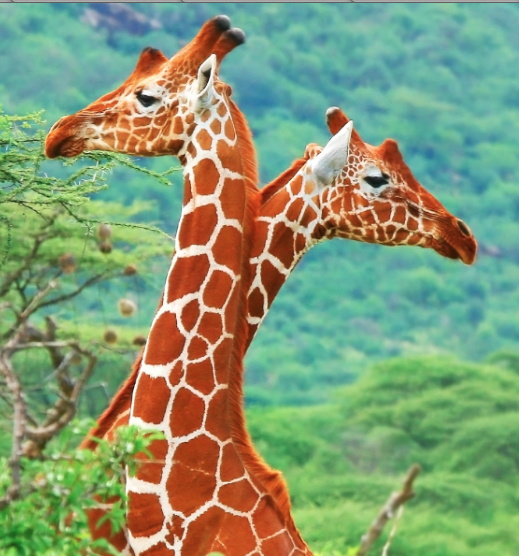WHY SUCH A LONG NECK?
My oldest son loves Giraffes. I think they are very cool as
well, but I kept telling him that they are not endangered. As all my readers
know, I typically write about endangered animals because they need more
attention. Nevertheless, he insisted and
I agreed. So today we are going to talk about the Giraffe. What I read, as I
researched this wonderful animal, was a surprise to me and I hope you will
learn something too.
When I begin reading about the Giraffe I came upon a startling
revelation (surprise). The
population of the Giraffe has dropped dramatically since the count of 140,000
in 1999 (giraffeconservation.org.) Current population estimate, taken by the
IUCN*, is 80,000 animals. This fact
tells us that the Giraffe may not be endangered according to the required
factors, but it certainly is in trouble.
Efforts by the IUCN are underway to determine a more accurate count of
the Giraffe population, and what they need to do to insure that the numbers do
not decline further. One important fact
you need to understand is that this population count includes all of the
subspecies of Giraffes. There are nine subspecies of Giraffe and two of those subspecies are endangered. So I learned something I didn't know before - and that's a good thing! :-)
The name Giraffe comes from the Latin ‘camelopardalis,’
which means ‘camel marked like a leopard.’ That makes sense to me. The blotches
on their fur help to camouflage them while they are feeding in the dappled
sunlight beneath the acacia trees.
Poaching, human population growth, and habitat loss continue
to have an effect on the Giraffe’s numbers on the continent of Africa. The map
you see below shows the populations of subspecies of Giraffes. The populations are fragmented and this is
also a contributing factor to its decline. If the populations are fragmented,
which means separated, then Giraffes can't get together to produce more
offspring.
Photo Credit – IUCN
Of the nine subspecies, two are actually listed as
endangered, so this blog post is indeed about an endangered animal. The two
endangered subspecies are, the Rothschild Giraffe, and the West African
Giraffe. However, we will not focus on these two endangered species. We will
talk about Giraffes as a whole since they all have similar biology and physical
characteristics. The subspecies are different from one another in terms of
their fur patterns and slightly different coloration. You can see the different patterns and color
in the below illustration, and where those fragmented populations live.
Photo Credit: Wikipedia
Can you identify which Giraffe wears the below pictured fur? Use the illustration above to help you decide.
The coloration of the Giraffe is mainly for camouflage. However,
it is also used as a cooling mechanism. Beneath the patches of color on their fur,
is an intricate network of tiny blood vessels that help to cool the animal by
releasing body heat.
Photo credit: giraffeconservation.org
So lets talk about some of more interesting characteristics.
First the obvious; the Giraffe has a very long neck. The male, or bull as they
are called, can reach a height of 19 feet high with the neck being about 8-9
feet of that length. Although their neck is the longest of all animals, they
still have the same amount of bones that humans and other mammals have in their
necks. J
Photo credit:
pagersource.com
So why do they have such a long neck? Evolution has favored,
over thousands of years, the Giraffe with the longer neck. That longer necked
Giraffe was able reach the leaves on a tree that other animals could not. It became a characteristic that helped the
Giraffe to survive and produce more Giraffes with longer necks. This change was a slow progression, which resulted in the
long necked animals we see today.
Not only does their long neck help them reach their meal, they
also use their superior height to keep an eye on their surroundings. They are
very tall sentinels
(lookouts), watching for predators across the African savanna (plains).
The males have developed a ritualized ‘necking’ behavior,
which helps them to establish dominance over other males. They butt heads and
wrap their necks around their rival with powerful swings. They aim for their
rival’s neck and underbelly to deliver intense blows until one of them backs
down. These blows can be so strong that their impact has been known to knock an
animal unconscious.
A Giraffe has a very strong, long tongue. Not only is it
strong and long, it is also blue and prehensile
(able to grasp). The tongue can be 18-20 inches long and the Giraffe uses it to
twist the leaves off of the tops of trees. It has been suggested that the dark
color of the tongue protects it from the sun. Umm…
The Giraffe likes to eat a lot of leaves and can consume up
to 95 pounds of leaves in a day. They like acacia trees, as well as many others.
Their grazing and ‘trimming’ of the trees on the African savannah has actually
caused the trees to grow into a very particular shape. The video I have found
for you will explain this in a bit more depth. Giraffes get most of their
moisture from the leaves they eat. As a result, unlike many other mammals in
Africa, the Giraffe does not migrate and it lives in loose social groups.
Here’s the video I promised!
For more information on this spectacular animal, visit the following sites:
My thanks to ARKive.org for some of the information and
pictures.
Thanks also to all my readers for visiting. Hope you enjoyed
this week’s post and that you’ll return again next week.
*IUCN = International Union for Conservation of Nature
Enjoy!
Jeanne E. Rogers, Author
The Sword of Demelza, an Award Winning Adventure Where
Endangered Animal Heroes Roam the Pages








